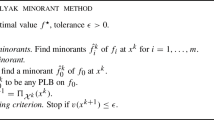Abstract
This paper describes the experimental results of testing a “large-scale” program for solving minimum-cost network flow problems. With this program, general structure transshipment problems with over ten thousand nodes and thirty thousand arcs have been easily solved without resorting to auxiliary storage. The algorithm is a variant of the primal revised simplex method; the computer code is called LPNET illustrating the close connection between linear programming and network graphs. This approach substantially improves computer processing timeand core storage, especially for relatively large network problems. The results of these experiments are provided. It is emphasized that an organized experimental design and a detailed series of empirical tests are crucial for an efficient implementation.
Similar content being viewed by others
References
R.S. Barr, F. Glover and D. Klingman, “An improved version of the out-of-kilter method and a comparative study of computer codes”,Mathematical Programming 7 (1974) 60–86.
G.H. Bradley, G.G. Brown and G.W. Graves, “Design and implementation of large-scale primal transshipment algorithms”,Management Science 24 (1977) 1–34.
A. Charnes and W.W. Cooper, “The stepping stone method of explaining linear programming calculations in transportation problems”,Management Science 1 (1954) 49–69.
A. Charnes and W.W. Cooper,Management models and industrial application (Wiley, New York, 1961).
A. Charnes, F. Glover, D. Karney, D. Klingman and J. Stutz, “Past, present, and future of large-scale transshipment computer codes and applications”, Research Rept. CS 131, University of Texas at Austin (1973).
H. Crowder and J.M. Hattingh, “Partially normalized pivot selection in linear programming”,Mathematical Programming Studies 4 (1975) 12–25.
H.P. Crowder, R.S. Dembo and J.M. Mulvey, “Reporting computational experiments in mathematical programming”,Mathematical Programming, to appear.
W.H. Cunningham, “A network simplex method”,Mathematical Programming 11 (1976) 105–116.
G.B. Dantzig,Linear programming and extensions (Princeton University Press, Princeton, NY, 1963).
J.C. Dickson and F.P. Frederick, “A decision rule for improved efficiency in solving linear programming problems with the simplex algorithm”,Communication of Association of Computing Machinery 3 (1960) 509–512.
B. Gavish, P. Schweitzer and E. Shlifer, “The zero pivot phenomenon in transportation and assignment problems and its computational implications”,Mathematical Programming 12 (1977) 226–240.
G.E. Gilliam and S. Turner, “A network model to reduce the size of microfile data”, presented at the Joint National Meeting of ORSA/TIMS, Las Vegas, NV (1975).
F. Glover, D. Karney and D. Klingman, “Implementation and computational comparisons of primal, dual and primal-dual computer codes for minimum cost network flow problems”,Networks 4 (1974) 191–212.
F. Glover and D. Klingman, “Real world applications of network related problems and breakthroughs in solving them efficiently”, Research Rept. CS 159, University of Texas at Austin (1974).
F. Glover and D. Klingman, “Network application in industry and government”, Research Rept. CS 247, University of Texas at Austin (1975).
F. Glover and D. Klingman, “Improved labeling of LP bases in networks”, Research Rept. CS 218, University of Texas at Austin (1975a).
F. Glover, D. Klingman and J. Stutz, “The augmented threaded index method”,INFOR 12 (1974) 193–198.
F. Glover and J.M. Mulvey, “The equivalence of the 0–1 integer programming problem to discrete generalized and discrete pure network models”, HBS 75-46, Harvard University (1975), to appear.
D. Goldfarb, “Using the steepest-edge simplex algorithm to solve sparse linear programs”, in: J.R. Barch and P.J. Rose, eds.,Sparse matrix computations (Academic Press, New York, 1976).
G.W. Graves and R.D. McBride, “The factorization approach to large-scale linear programming”, Working Paper No. 208, Western Management Science Institute, University of California at Los Angeles (1973).
H.J. Greenberg and J.E. Kalan, “An exact update for Harris' TREAD”,Mathematical Programming Study 4 (1975) 26–29.
P. Harris, “Pivot selection methods of the Devex LP code”,Mathematical Programming 5 (1973) 1–28.
D. Karney and D. Klingman, “Implementation and computational study on in-core out-of-core primal network codes”,Operations Research 24 (1976) 1056–1077.
M. Klein, “A primal method for minimal cost flows with application to the assignment and transportation problems”,Management Science 14 (1967) 205–220.
D. Klingman, A. Napier and G. Ross, “A computational study on the effects of problem dimensions on solution time for transportation problems”, Research Rept. CS 135, University of Texas at Austin (1973).
D. Klingman, A. Napier and J. Stutz, “NETGEN: A program for generating large-scale assignment, transportation, and minimum cost flow network problems”,Management Science 20 (1974) 814–821.
D.E. Knuth,The art of computer programming, Vol. I: Fundamental algorithms (Addison-Wesley, New York, 1968).
D.E. Knuth,The art of computer programming, Vol. III: Searching and sorting (Addison-Wesley, New York, 1973).
R.D. McBride, “Factorization in large-scale linear programming”, Working Paper No. 200, Western Management Science Institute, University of California at Los Angeles (1973).
J.M. Mulvey, “Special structures in large-scale network models and associated applications”, Ph.D. dissertation, University of California at Los Angeles (1975).
J.M. Mulvey, “Pivot stragegies for primal-simplex network codes”,Journal of the Association for Computing Machinery 25 (1978) 266–270.
B.N. Pavlett and Y. Wong, “The influence of the compiler on the cost of mathematical software—in particular on the cost of triangular factorization”,Association for Computing Machinery Transactions on Mathematical Software 1 (1975) 35–46.
V. Srinivasan and G.L. Thompson, “Accelerated algorithms for labeling and relabeling of trees, with applications to distribution problems”,Journal of the Association for Computing Machinery 19 (1972) 712–726.
V. Srinivasan and G.L. Thompson, “Benefit-cost analysis of coding techniques for the primal transportation algorithm”,Journal of the Association for Computing Machinery 20 (1973) 194–213.
Author information
Authors and Affiliations
Additional information
Research supported in part by TRW Systems Group and Harvard Business School.
Rights and permissions
About this article
Cite this article
Mulvey, J.M. Testing of a large-scale network optimization program. Mathematical Programming 15, 291–314 (1978). https://doi.org/10.1007/BF01609034
Received:
Revised:
Issue Date:
DOI: https://doi.org/10.1007/BF01609034




